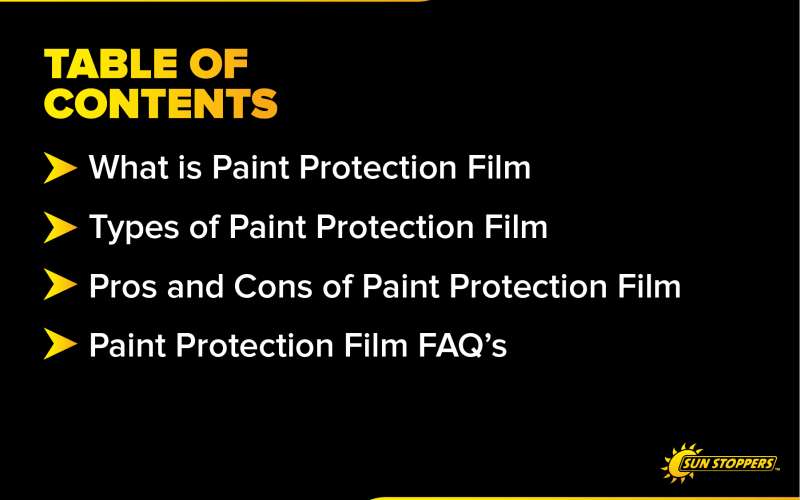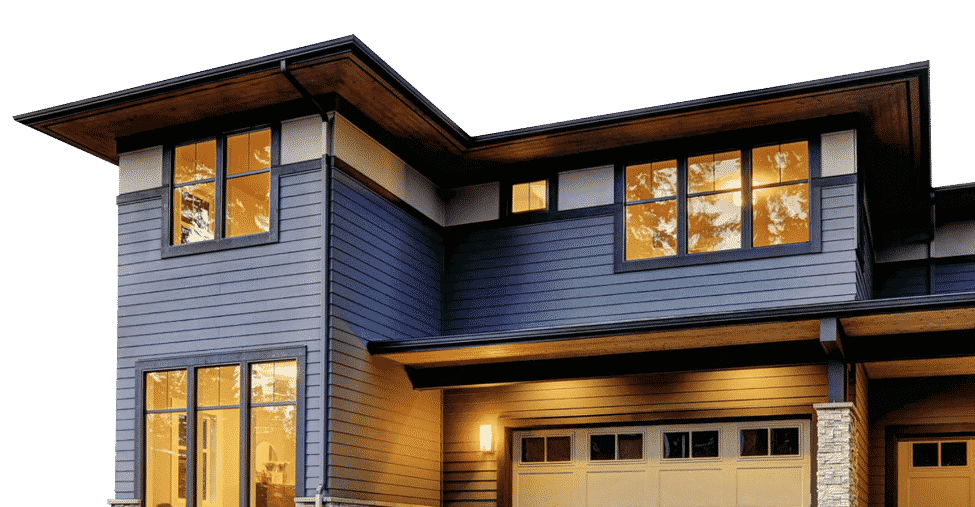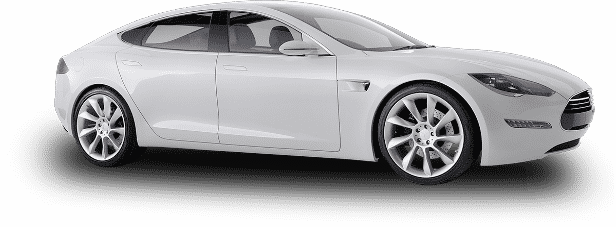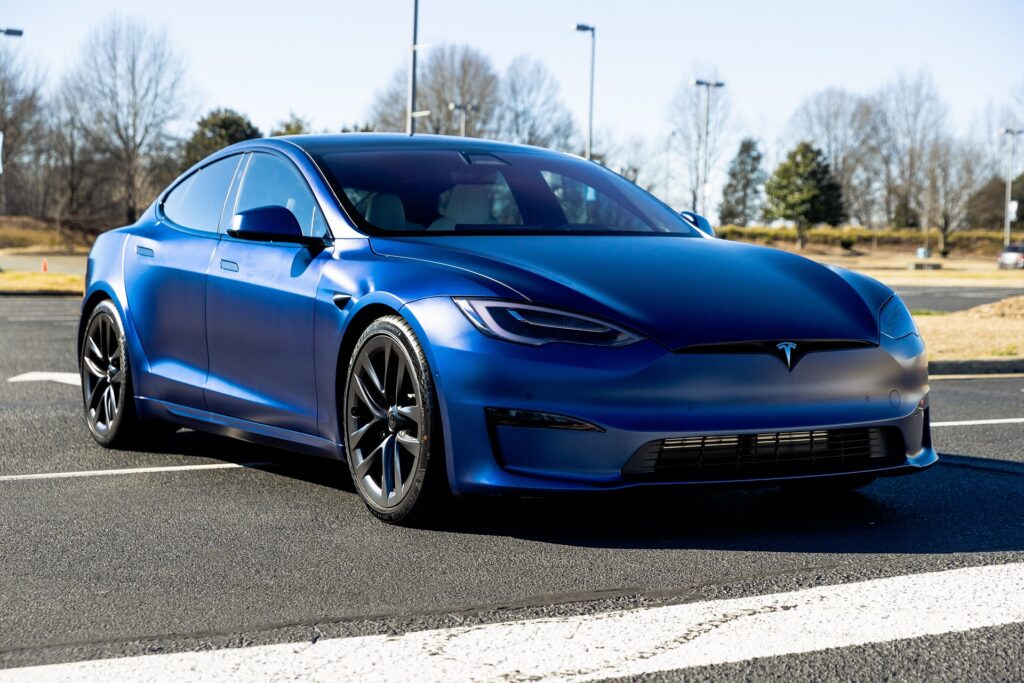Your new vehicle turns heads – its immaculate paint job gleams in the sunlight, the wheels shine, and the finely tuned engine hums.
Sadly, It won’t be that way for long though.
Before you know it, you have rock chips in your paint, bird excrement baked on the exterior, or scratches from normal wear and tear.
Fixing the blemishes on your pride and joy costs a lot of money, and is a constant task.
That’s why we’re so excited about paint protection film here at Sun Stoppers.
This car paint protection helps prevent damage from tree sap, road debris, rock chips, and sand and bugs. Plus, it can save you thousands in paint repairs.
Want to learn more? Let’s dig in!

What is Paint Protection Film?
Paint protection film (PPF) is a thermoplastic urethane film applied to painted surfaces of a new or used car in order to help protect the paint from stone chips, bug splatters, and minor abrasions.
PPF has been around since the 1950’s and has more recently become popularly known as clear bra.
But where did paint protection film come from in the first place?
The History of PPF
At the height of the Vietnam War, and the U.S. Department of Defense (D.O.D.) was receiving one report after another of helicopters being significantly damaged by shrapnel and debris. This was especially apparent on areas like rotor blades, and across surfaces carrying sensitive military equipment.
In order to help protect these moving parts, the US military asked 3M to come up with a solution that was both inconspicuous and low-weight.
The result was the first edition of paint protection film.
3M’s engineers developed a product that could withstand both significant amounts of elemental abuse, and moderate surface damage from things like artillery shrapnel.
Inexpensive, relatively easy to apply and replace, and resistant to UV degradation and common aviation fluids, this film was an instant success.
![Paint Protection Film (PPF): Everything you need to know [& 5 reasons your car needs it] 2 paint protection film was first used by the United States military](https://sunstoppers.com/wp-content/uploads/2021/11/paint-protection-film-was-first-used-by-the-United-States-military-768x511.jpg)
As you already know, products that are military grade are generally very high quality materials – and PPF is no exception.
That’s why it doesn’t come as a surprise that NASCAR got on board with urethane films to protect the front ends of their race cars. For a sport that relies so heavily on sponsorship decals, urethane film was a game-changer to keep these vehicles looking better.
Finally, in the 1990s, urethane film was made available to the general public for automotive protection. This technology has been improved and refined over the years as well, giving us a final product that’s popular among owners and manufacturers alike.
Paint Protection Film vs. Ceramic Coating
Those that want to protect the paint on their vehicles often explore ceramic coating as an alternative to paint protection film.
At first glance, this makes sense.
Ceramic coating is a liquid polymer that is applied to the exterior surfaces of a vehicle. After application, it chemically bonds with the vehicle’s factory paint, establishing a layer of protection and a hydrophobic surface.
And ceramic coating does help your vehicle look amazing for a longer period of time.
However, the main job of a ceramic coating is to keep your car cleaner for longer periods of time, and to make your vehicle easier to wash when that time comes.
Ceramic coating can also help to prevent some kinds of damage to the pain your vehicle like:
- Chemical stains caused by acidic contaminants
- Oxidation (fading) from UV exposure
However, there are significant differences between paint protection film and ceramic coating.
Paint protection film is thicker than ceramic coatings. Moreover, PPF has a chemical composition that allows it to self-heal. These qualities make Paint Protection Film better able to absorb rock chips, small scratches, swirl marks, and hard water spots without being permanently disfigured.
A ceramic coating does not have that ability.
In other words, paint protection film can stop a rock from chipping your paint, but ceramic coating can’t.
![Paint Protection Film (PPF): Everything you need to know [& 5 reasons your car needs it] 3 ceramic coating vs paint protection film](https://sunstoppers.com/wp-content/uploads/2021/11/table-of-contents-768x512.png)
If your main goal is protecting the paint on your vehicle, then paint protection film is the way to go.
If you care more about a product that enhances the gloss of your paint and creates a hydrophobic surface that is easy to clean, then ceramic coating may be your best bet.
If you want to get the best of both worlds a ceramic coating on top of paint protection film offers exceptional protection to your vehicle.
If you are interested in a ceramic coating or paint protection film stop by a Sun Stoppers store location near you. We offer the highest quality vehicle protection services. But don’t take our word for it – just check out our hundreds of 5-star reviews.
Types of Paint Protection Film
You already know that some particular brands and materials within product lines are better than others.
For example, a $7 chef’s knife with a hollow handle is a struggle at every meal, whereas a quality $35 knife makes food preparation effortless.
Or maybe it’s the $1 toothbrush that leaves your teeth feeling grimy vs. the $20 electric toothbrush that makes them feel like you just had a dental cleaning after every brush.
The point is that all products are not created equally – some are better than others. This is certainly true for paint protection film!
Let’s make sure you are getting the good stuff!
Paint Protection Film Thickness
If you purchase a paint protection film that is too thin, it won’t do the job it is advertised to accomplish.
PPF with a thickness of about 6 mils (not including adhesive, clearcoat, or release liner) is recommended to provide top-tier protection. Any high quality paint protection should be at least this thick – some are up to 12 mils thick.
![Paint Protection Film (PPF): Everything you need to know [& 5 reasons your car needs it] 4 high quality paint protection film is installed on a vehicle](https://sunstoppers.com/wp-content/uploads/2021/11/high-quality-paint-protection-film-is-installed-on-a-vehicle-768x512.jpg)
However, many low-quality urethane films are not thick enough and don’t protect your vehicle as they should.
We recommend asking the manufacturer or dealer how thick the paint protection film you are considering is before purchasing.
Paint Protection Film Styles
Paint protection film didn’t transition immediately from the army to civilian use because the film wasn’t totally transparent when it was first developed.
While the army didn’t mind if their helicopters looked a little different, someone trying to protect their vehicle didn’t want something that made the paint appear hazy.
That’s why the main style of paint protection film is designed to be crystal clear – creating an invisible shield for your vehicle’s exterior (this is the opposite of vinyl wrap which comes in different colors, finishes, and textures and is mainly used for the purpose of altering the look of your car).
However, in recent years, more styles of paint protection film have become available. You can get:
Just choose the style you like best, find an expert installer, and you’re set to go!
![Paint Protection Film (PPF): Everything you need to know [& 5 reasons your car needs it] 5 paint protection film gives a car a beautiful matte finish](https://sunstoppers.com/wp-content/uploads/2021/11/paint-protection-film-gives-a-car-a-beautiful-matte-finish-768x512.jpg)
Top 4 Paint Protection Film Brands
If you’re looking to get paint protection film installed on your vehicle, starting with a high quality film is a good place to start.
Here are a few trusted names in the PPF industry that have proven that they can manufacture a film that gets the job done.
1. XPEL
XPEL is a well-known purveyor of automotive paint protection products and we’d comfortably suggest its paint protection film to any vehicle owner. In fact, many argue that XPEL makes the best PPF on the market. XPEL also backs their films with a 10 year warranty.
You can find many different styles of paint protection film from XPEL including:
- XPEL Ultimate Plus: one of the most advanced paint protection films on the market. Available in three different thicknesses to offer you the protection you need for exterior and interior surfaces.
- XPEL Stealth: A Paint Protection Film specifically formulated for preserving a flat factory finish.
- XPEL Interior Protection: A paint protection film designed for the inside of your vehicle. It keeps surfaces free of fine scratches, swirls and blemishes.
- XPEL Tracwrap: An easy DIY solution for those who want to hit the tarmac but are sick of using blue tape. It’s easy to install and remove!
- XPEL Armor: Utilizes a 13 mil construction to resist abrasions and punctures from even the most aggressive terrain.
![Paint Protection Film (PPF): Everything you need to know [& 5 reasons your car needs it] 6 XPEL is considered an industry leader in paint protection film](https://sunstoppers.com/wp-content/uploads/2021/11/XPEL-is-considered-an-industry-leader-in-paint-protection-film-768x512.jpg)
2. 3M
3M’s Scotchgard as it is a very long-lasting clear paint protection film. The 3M company is also a global leader in films, adhesive products, and laminates. The company’s paint protection film is a clear polyurethane film that is 8 mils (0.0008″) thick with adhesive backing.
This very thin, transparent film can be applied to the front of your vehicle, acting as a clear “bra” to shield your car from debris. Users say it’s long lasting, extremely sticky and relatively easy to apply
And, just like XPEL, 3M backs their films with a 10 year warranty.
3. SunTek
SunTek’s paint protection film is typically only sold in large quantities (it’s typically used by professionals, hence the bulk unit sizes) but that makes it good for covering the entire front end of your car or truck, including the hood.
SunTek also sells matte film in addition to the usual gloss film, so it can be used on matte paint jobs. It’s also backed by a five-year manufacturer’s warranty.
4. VViVid
This paint protection film aims to be easy to apply—it can be stretched without having to use a heat gun and features “ultra conformable” compounds so it will contour to whatever you’re trying to apply it to.
This inexpensive film is also highly resistant to abrasions, light damage, and yellowing, the manufacturer says.
With a cheap entry-price and good durability, the VViViD Clear Paint Protection Film is a decent product, although we’d say it’s inferior to others from 3M, XPEL, and SunTek.
Pros and Cons of Paint Protection Film
If you want to protect the paint on your vehicle you are likely reading this article with one goal in mind:
Is paint protection film the best option for protecting my car?
Let’s dig into all the pros and cons of PPF so you can make an informed decision for yourself!
Pros of Paint Protection Film
Help Stop Exterior Damage
We list exterior protection as the first benefit of paint protection film, because this is its number one job.
Stones, sand, tar, and other road debris wreak havoc on your car’s paint. If that’s not enough acid rain, bugs, and bird dropping will finish the job.
However, paint protection film can help keep all that from happening.
![Paint Protection Film (PPF): Everything you need to know [& 5 reasons your car needs it] 7 paint protection film protects a vehicle from stones, sand, tar, and other road debris](https://sunstoppers.com/wp-content/uploads/2021/11/paint-protection-film-protects-a-vehicle-from-stones-sand-tar-and-other-road-debris-768x512.jpg)
Lightweight and transparent, paint protection film is seamlessly applied to the exterior of your vehicle, which aids in preventing the paint from fading and damaging.
Once a product like XPEL’s Ultimate Plus Paint Protection is adhered to the paint on your vehicle, the old concerns of worrying about the film peeling, cracking, fading, aging, yellowing or blistering are no more with XPEL’s 10-year warranty against any of this happening to the film.
Self Heal Scratches
This is where XPEL’s PPF begins to take things to the next level.
Not only does this premium paint protection film guard against everyday threats like gravel and bugs, it also self-heals when it is scratched.
That’s right – you can take a wire brush (up to 6 mil) to paint protection film, and then pour warm water on it and watch the scratches disappear.
Amazing!
Boost Vehicle Aesthetics
There are numerous ways of protecting a vehicle. For example, you could attach a huge steel bumper to the front of your truck to eliminate the risk of animals damaging it.
However, that fix wouldn’t look great.
On the other hand, paint protection film enhances the aesthetics of a car as soon as it is applied.
You can’t see the film with the naked eye – but you can tell that it makes your vehicle glisten like new!
You can also get unique paint protection films that give your vehicle an attractive finish. Take for example, the XPEL Stealth PPF. This allows you to create a whole new attractive matte finish for your car!
With PPF you get protection and boosted vehicle aesthetics. It’s a win-win!
![Paint Protection Film (PPF): Everything you need to know [& 5 reasons your car needs it] 8 paint protection film protects vehicles and makes them look good](https://sunstoppers.com/wp-content/uploads/2021/11/paint-protection-film-protects-vehicles-and-makes-them-look-good-768x512.jpg)
Save Money On Expensive Vehicle Repairs
Have you ever needed to repaint a vehicle?
If not, count yourself lucky.
While the cost to paint a car varies on many factors, you can expect to pay $5,000 for a high-quality paint job.
In other words:
You want to avoid repainting your car if at all possible.
And here’s the thing:
Every time your paint is punctured – even if it’s just a tiny chip from a piece of gravel – the protective barrier is broken and an area is created where rust and other damage can set in.
That’s why making the investment in paint protection film and getting armor for your car can save you tons of money in the end.
Maintain Resale Value
If you are a car fanatic, there’s a good chance you are buying a new one every couple of years.
That means you want to get a good resale value of the car you currently have – and paint protection film can help with that. After all, who wants to buy a car that has scratched paint?
Not only will it keep the paint looking good and prevent damage that could detract from value, but savvy buyers also understand the value of this investment and will pay more for a car that has it.
![Paint Protection Film (PPF): Everything you need to know [& 5 reasons your car needs it] 9 paint protection film boosts the resale value of a vehicle](https://sunstoppers.com/wp-content/uploads/2021/11/paint-protection-film-boosts-the-resale-value-of-a-vehicle-768x512.jpg)
Cons of Paint Protection Film
Obviously paint protection film has a ton of upside – but are there any reasons you should avoid it?
Let’s check a few out.
Upfront Costs
It’s obvious: applying a paint protection film is more expensive than leaving your paint as it is.
And to be honest, if you don’t mind a few dings, scratches, and eventually faded paint, paint protection film may not be for you.
However, if you care about maintaining a pristine look for your car, the upfront cost is worth it. Plus, you can minimize expenses by opting for protective films only in areas commonly exposed to impacts and contaminants.
The Film Could Be Applied Incorrectly
The best products in the world don’t work when they aren’t utilized correctly.
Unfortunately, a paint protection film is only a reliable solution if applied across the full surface area in a smooth manner, free of ripples, wrinkles, and bubbles.
You can avoid the risks of an improper application by using an installer with a great reputation that does incredible work.
We encourage anyone that is considering a PPF to do careful research and choose an installer that they can trust.
At Sun Stoppers, our technicians are trained to do an outstanding job and pay attention to every detail when installing paint protection film.
![Paint Protection Film (PPF): Everything you need to know [& 5 reasons your car needs it] 10 a professional installs paint protection film on a vehicle](https://sunstoppers.com/wp-content/uploads/2021/11/a-professional-installs-paint-protection-film-on-a-vehicle-768x512.jpg)
Needs to be Replaced
Paint protection films commonly feature warranties of 5, 10, or 12 years. After this time, the integrity of the film cannot be guaranteed, and may need to be replaced.
If you are the kind of person that drives a car until it sputters to a stop, paint protection film may not be for you.
However, most people don’t drive a vehicle for more than 10-12 years. And when you think of needing to redo an entire paint job in the span, paint protection film starts to seem like a worthwhile investment.
Paint Protection Film FAQ's
1. Can you see seams in paint protection film?
The short answer to this question is yes.
However, A good installer does an incredible job of hiding seams and there is a very high chance that you would never notice any seams from a quality job.
Remember, the name of the product is paint protection film, not paint perfection film. Going over any car that has been fully covered with paint protection film with a fine tooth comb will reveal a few seams in inconspicuous places.
2. Are there any alternatives to using PPF?
If you’re looking to protect your vehicle’s clear coat and paint from things like rock chips and scratches and it outlast anything else on the market, then PPF is the clear winner.
However, pairing a high-end, 9H-rated ceramic coating with a flawlessly installed PPF will create a shield that offers the best of both worlds, and should always be opted for by those looking for unrivaled protection.
3. Can I install paint protection film myself?
We highly discourage installing paint protection film yourself for a number of reasons.
First is that any current blemishes in your paint are only magnified when paint protection film is applied. And sadly, even brand new factory paint has blemishes.
Vehicle detailers like Sun Stoppers carefully decontaminate and polish the paint on your vehicle before applying paint protection film. Without this, you won’t be happy with the finished product.
![Paint Protection Film (PPF): Everything you need to know [& 5 reasons your car needs it] 11 decontaminate and polish vehicle paint before applying paint protection film](https://sunstoppers.com/wp-content/uploads/2021/11/decontaminate-and-polish-vehicle-paint-before-applying-paint-protection-film-e1638153261685-768x434.jpg)
The second reason is that specialized software is used to cut pieces of paint protection film that fit the different portions of your vehicle perfectly. Without this software, you have to use large pieces of PPF and then cut around all the details on your vehicle.
While an experienced installer may be able to accomplish this feat, there’s a good chance that a beginner will cut through the PPF and damage the paint – exactly what you are trying to avoid!
And finally, we want to remind you that a poor installation job completely negates all the benefits you stand to gain from applying paint protection film to your vehicle.
Seeing wrinkles, bubbles, or specks of dirt under the paint protection film is going to drive you crazy and make your vehicle look worse than it did before.
In this case, it’s worth it to take your vehicle to a professional detailer and get the job done right.
4. Where are the best places to install PPF?
There are several common options for installing paint protection film on your vehicle
- Partial front end: This includes PPF on the front bumper, headlights, side mirrors, and 18”-24” up the hood and fenders.
- Full front end: This is PPF installed on the front bumper, headlights, sider mirror and full good and fenders.
- Full car: every exposed painted surface is covered with paint protection film.
Of course, these are just the most common areas to apply paint protection film. In reality, you can get it installed anywhere you want on your car.
A few other commonly requested areas are the door handles, rocker panels, fender panels, and the trunk ledge.
Live A Better Life With Paint Protection Film
There’s a 100% chance something will damage the paint on your new vehicle – unless you protect it.
Don’t mess around and take the chance. Get paint protection film today and feel like a hero every time you get out of your vehicle.
If you are ready to install a PPF on your vehicle, find a Sun Stoppers location near you.
We’ve perfected the process of installing paint protection film – in fact we’re a little OCD about making sure every single detail is done perfectly. Plus, we use high quality paint protection film from XPEL!
We also offer other protective services for your vehicles like window tinting and ceramic coating.
We’ve also made sure to keep pace with the boom in electric vehicles! We offer Tesla window tinting, Tesla paint protection, and Tesla ceramic coating.
If you want to learn more about protecting your vehicle in general, make sure to check out our blog on protecting your car.
In the meantime, let’s get started on the super easy process of working with us. All you have to do is:
- Get a FREE ESTIMATE
- Bring your vehicle to the nearest Sun Stoppers and enjoy fast, and professional application.
- Drive with confidence!
Contact us today. We look forward to hearing from you!



 Visit Us Today
Visit Us Today


![Paint Protection Film (PPF): Everything you need to know [& 5 reasons your car needs it] 1 paint protection film 1](https://sunstoppers.com/wp-content/uploads/2021/11/header.jpg)

